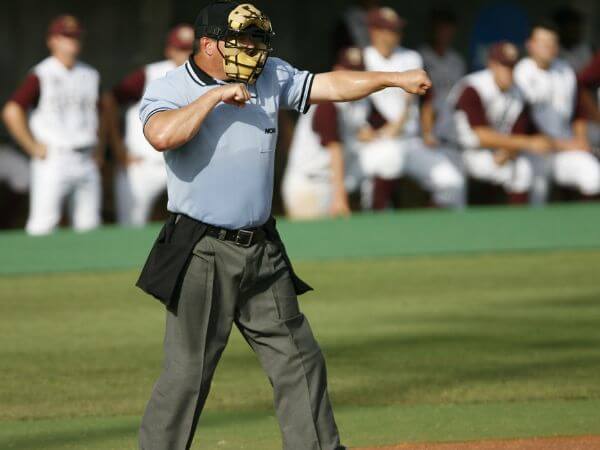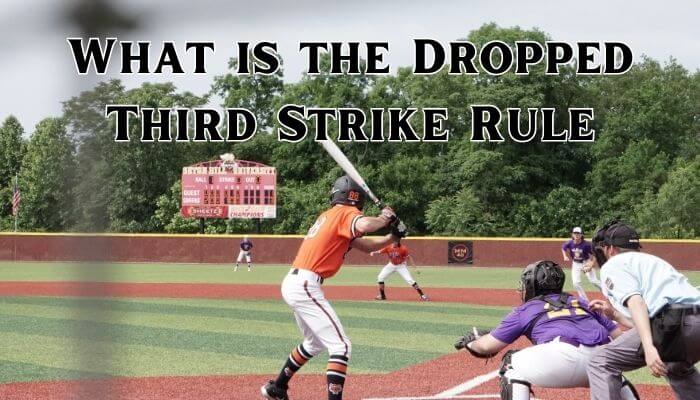Step up to the plate and get ready for a swing at one of baseball’s most intriguing rules: the dropped third strike rule. This rule can be confusing for some fans, and some may find it not a good one. But rules are rules. Let’s discuss this in brief.
What is the dropped third strike rule in baseball?
The dropped third strike rule in baseball is a fascinating and sometimes controversial aspect of the game.
It occurs when the catcher fails to catch a pitched ball that is swung at and missed by the batter, resulting in an uncaught third strike.
This rule gives the batter an opportunity to become a baserunner, even after striking out.
On a third strike, if the ball hits the ground, the batter is given permission to advance to first. The batter is out if the catcher gets the ball and throws it to the first baseman before the batter reaches first, but if the batter reaches first safely, there is no out.
Options Available to the Batter after a Third Strike is Dropped
After a third strike is dropped by the catcher, the batter has two options available to them. They can choose to run to first base. This option is only available if there are fewer than two outs and the first base is unoccupied or occupied with two outs. And the second option is to stay on the base and do nothing.

The role of the catcher in the dropped third strike rule is crucial. When a batter swings and misses at a third strike, but the catcher fails to catch the ball cleanly, it becomes an uncaught third strike. In this situation, the catcher must quickly retrieve the ball and either tag out or throw out the batter at first base before they reach safely.
As soon as it becomes clear that the pitch will be a swinging strike, experienced catchers immediately position themselves in a way that allows them to react swiftly if needed. They need to be agile and have excellent reflexes to secure any potential rebounded balls efficiently.
Timing is essential for catchers when executing plays on dropped third strikes because they must ensure they can make accurate throws while also preventing baserunners from advancing. The catcher’s ability to read both their pitcher’s delivery and anticipate potential wild pitches or passed balls is vital in these situations.
Umpire’s Role and Interpretation

The dropped third strike rule in baseball is not without controversy, and the role of the umpire in interpreting this rule is crucial.
If there are no runners on base or if there are two outs with runners on first base occupied, then the batter becomes a runner after the dropped third strike. However, suppose there are fewer than two outs with runners on first base unoccupied or any other combination of bases occupied, including bases loaded. In that case, the batter does not automatically become a runner.
It is up to the umpire’s discretion to determine whether an attempted swing occurred on that final pitch. If they deem that no swing was made despite contact between bat and ball, then it cannot be ruled as a dropped third strike.
Umpires play a vital role in ensuring fair play by making accurate judgments based on their interpretation of game situations. Their decisions can impact both individual at-bats and overall game outcomes.
What Conditions are Necessary for Dropped third strike (uncaught third strike)
Conditions necessary for a dropped third strike, also known as an uncaught third strike, can vary depending on the specific rules and interpretations of the game. In general, there are a few key factors that come into play.
The pitch itself must be considered a legal strike by the umpire. This means that it must cross over any part of the home plate within the designated “strike zone.” If the pitch is outside this zone or deemed illegal (such as a ball), then it cannot result in a dropped third strike.
For a dropped third strike to occur, there must be less than two outs in the inning. This is because if there are already two outs recorded before the pitch is thrown, then no matter what happens with that particular play, it will not affect whether or not an out is recorded.
And perhaps most importantly, once the catcher fails to cleanly catch and secure the ball after a swing and miss on strike three by the batter (the so-called “dropped” third strike), several outcomes become possible based on other situational factors such as baserunners and their movements.
History of the Dropped Third Strike Rule
The history of the dropped third strike rule in baseball dates back to the early days of the sport. In its original form, there was no distinction between a caught and uncaught third strike. However, as the game evolved, so did the rules surrounding this particular situation.
It was in 1901 that Major League Baseball officially adopted the dropped third strike rule. This change allowed for a batter to become a runner if they swung at and missed a pitch for their third strike, but it was not caught by the catcher.
Prior to this rule change, batters were automatically out on any swing and miss regardless of whether or not it was caught.
Over time, the rule underwent numerous technical shifts, including the determination of whether or not a dropped third strike was a fair ball or foul. The unintended result of this was that catchers could deliberately drop a third strike (or strikeout pitch) to start a double play.
Various adjustments have been made to clarify and refine the dropped third strike rule. These changes aim to maintain fairness and balance between pitchers and batters while also keeping with tradition.
Today, the dropped third strike rule remains an important part of baseball strategy. It adds an additional layer of excitement and unpredictability to games as players must quickly react and make split-second decisions based on whether or not a pitch has been caught by the catcher.
As with many aspects of baseball, the interpretation of these rules can vary among umpires which can sometimes lead to controversy or debate during games. Nonetheless, understanding the history behind such rules helps create an appreciation for how they have shaped America’s pastime over time.
Reasons for the Dropped Third Strike Rule’s Existence
The dropped third strike rule adds an element of excitement and unpredictability to the game. It allows for potential comebacks and rally opportunities for the offensive team. Without this rule, a strikeout would automatically result in an out, limiting the chances of a team turning things around.
The dropped third strike rule rewards skillful baserunning and encourages aggressive play on the basepaths. When a batter swings at a pitch but fails to make contact, it gives runners on base an opportunity to advance or steal bases if they can anticipate that the catcher will not cleanly catch the ball.
Additionally, allowing batters to reach first base on a dropped third strike potentially prevents pitchers from relying solely on strikeouts as their primary strategy. This helps maintain a balance between pitching dominance and offensive opportunities throughout the game.
While there may be differing opinions on whether or not this rule should exist, it is clear that its presence adds another layer of excitement and strategy to America’s favorite pastime.
Whether you’re cheering for your favorite team or simply enjoying watching or playing baseball yourself, understanding and appreciating these rules enhances your overall experience of the game.
Examples of When the Dropped Third Strike Has Been Used in Major League Baseball
Over the years, there have been numerous instances where the dropped third strike rule has come into play in Major League Baseball. One notable example occurred during Game 5 of the 2017 World Series between the Houston Astros and Los Angeles Dodgers.

Realizing his opportunity, Barnes sprinted toward first base while McCann scrambled to retrieve the ball.
Another memorable moment involving the dropped third strike rule came during a regular season game between the New York Yankees and Boston Red Sox in 2004. With two outs and a runner on first base, Yankees batter Jorge Posada swung at a pitch but missed. The ball eluded Red Sox catcher Jason Varitek’s grasp as it bounced toward the backstop.
Posada immediately took off towards first base as Varitek hurriedly retrieved the ball. Despite throwing to first baseman David Ortiz in an attempt to get Posada out, he was unsuccessful due to Posada’s speed down the line.
These are just a few examples. But there are many examples of dropped third strike rule in the MLB.
Can you Run on a Dropped Third Strike with Bases Loaded?
In order to uncover the solution, we need to take a second look at the conditions that must be met before the dropped third-strike rule may be implemented. The batter has little chance of reaching first base, given that less than two outs are remaining in the inning.
If there are already two outs, the hitter might try to advance to first on a dropped third strike. However, if there are no outs and there are runners on base, a force out can be accomplished at any base by simply picking up the ball and stepping on home plate.
Can a runner score on a dropped third strike?
Yes, it is possible for a runner to score on a dropped third strike.
When there are runners on base, and the batter strikes out but reaches first base safely due to an uncaught third strike, any runners who were already on base have the opportunity to advance. If there are two outs, this can result in potential runs being scored.
However, it’s important to note that whether or not a runner can actually score depends on several factors, such as the positioning of other baserunners and the speed of their movements. Additionally, if the catcher retrieves the ball quickly and throws it successfully to first base before the batter-runner reaches safely, then no runs will be scored.
How is a dropped third strike scored?
A strikeout is recorded with a K whenever a batter drops their third strike. Catchers will also be penalized with an error, denoted by the notation E2 if they are unable to recover the ball and make a throw first before the runner reaches the base.
A 2-3 putout is awarded to the team if the catcher is able to recover the ball and throw it to first base for the putout.
As a result, the play is scored as K-E2 if the runner crosses the plate but as K-2-3 if they are out. If the runner is caught, the play is recorded as K-2-3. Other outcomes are possible if the out is recorded by the catchers at a different base, but the K is the starting point for any score that results from a dropped third strike.
How does a dropped third strike affect the batting average?
Now, you might be wondering why this matters. Well, it all comes down to how batting averages are calculated. A player’s batting average is determined by dividing the number of hits they have by their total number of at-bats. The thing is, if a dropped third strike counts as an out, then it also counts as an at-bat.
This means that even if the batter reaches base after the dropped third strike, their batting average will still take a hit because the failed bat will be counted against them. So whether the batter ends up making it to first base or gets thrown out trying to reach, their batting average will go down regardless.
It may seem unfair for a batter whose ball was not caught to have their stats affected negatively, but those are just the rules of the game. The Dropped Third Strike Rule has been in place for years and serves to keep things consistent and fair across all levels of play.
Does a dropped third strike count as an out?
The Dropped Third Strike Rule states that if a batter swings and misses at the third strike, but the catcher fails to catch the ball cleanly, the batter can still attempt to reach first base.
In this scenario, the strikeout is not counted as an out on the official scorecard. However, it will still be recorded as a strikeout for statistical purposes. Instead of registering an out, an error is charged to the catcher for allowing the batter to advance to first.
While not an official out, this situation often creates a discussion about how it affects the fielding team’s need to produce an extra out. This rule presents an opportunity for producing four outs instead of three in a single inning.
What is the Rule for Dropped third strike with a runner On First Base?
The number of outs that have been recorded in the inning plays a decisive role in determining whether or not the batter can advance to first base after the third strike is fallen. If there is already a runner on first base and there are two outs, the batter HAS THE OPTION OF RUNNING on a dropped third strike. When there are less than two outs and a runner is already on first base, the batter CANNOT advance even if the third strike is dropped.
What about if the runner is stealing?
Even if the runner who began the play on first base makes an effort to steal second base when the third strike is dropped, the conditions necessary for the dropped third strike rule to be applied will still be met. If there are already two outs, the batter is allowed to run the bases. In any other case, first base will be counted as occupied, and the dropped third strike will be recorded as a strikeout instead of a dropped third strike.
Dropped third strike little league rule
In Little League, the dropped third strike rule works similarly to the rule in professional baseball. If there are fewer than two outs and the first base is unoccupied, or if there are two outs regardless of the base occupancy, a batter can attempt to reach first base after striking out on a dropped third strike.
The purpose of this rule in Little League is similar to its purpose in professional baseball – it adds excitement and strategy by giving batters another chance after striking out. It also teaches young players about hustling and taking advantage of opportunities on the field.
It’s important for coaches and umpires in Little League games to ensure that both teams understand and abide by this rule. This helps create fair play situations where all players have an equal opportunity regardless of their batting performance.
Potential Changes to the Rule in the Future
As with any rule, there is always room for improvement and adaptation. The dropped third strike rule has been a part of baseball for many years, but that doesn’t mean it can’t be tweaked or revised in the future.
One potential change could be altering the options available to the batter after a third strike is dropped. Currently, they have the opportunity to run to first base if it’s unoccupied or if there are two outs. However, some argue that this rule puts too much pressure on catchers and can lead to errors or unfair advantages.
Another possible change could involve scoring. Currently, a dropped third strike does not count as an out, which means it doesn’t affect a batter’s batting average. But what if this were reconsidered? Perhaps implementing a new scoring system where a dropped third strike is counted as an out could add more strategic elements to the game.
Furthermore, technological advancements may play a role in shaping potential changes to the rule. With instant replay becoming more prevalent in sports, it wouldn’t be surprising if there were discussions about using technology to determine whether a pitch was actually caught by the catcher on a third strike swing.
While no specific changes have been proposed at this time, it’s important for baseball officials and fans alike to keep an open mind when considering potential adjustments to enhance fairness and excitement within the game of baseball.
FAQs on Dropped Third Strike Rule
What happens if the batter doesn’t attempt to run after a third strike is dropped?
In this situation, the batter is automatically out, regardless of whether they attempted to run or not. The dropped third strike rule allows the defense to make an out by either tagging the batter or throwing them out at first base.
Can a runner advance on a dropped third strike?
Yes, if there are less than two outs and first base is unoccupied, the runner can attempt to advance. However, if there are already two outs or first base is occupied, the runner cannot advance unless forced to do so.
Does a dropped third strike count as an earned run for the pitcher?
No, it does not. If a runner scores due to a dropped third strike and subsequently reaches home plate safely before any defensive play is made, it will be considered an unearned run.
Is there any limit on how many times a catcher can drop a third strike in one at-bat? No, there is no limit. The catcher can keep dropping consecutive strikes until they successfully tag the batter or throw them out at first base.
Do all leagues follow the same rules regarding dropped third strikes?
While most baseball leagues follow similar rules for dropped third strikes, some youth leagues may have variations in their interpretation of this rule. It’s always best to consult with your league’s specific regulations for accurate information.
Final Words
Whether you love it or loathe it, there’s no denying that the dropped third strike rule has become an integral part of America’s pastime. Its presence on the diamond ensures that every at-bat holds suspense until that final swing.
So next time you’re watching a baseball game and see a batter take a mighty cut at strike three only for the ball to hit the dirt – remember: anything can happen! The dropped third strike could turn defeat into victory in just one swift motion!
More Resources
How To Read A Baseball Scoreboard?
Stadium Pranks In Baseball Fields
What Is The Pennant In Baseball
What Is The Baseball Mercy Rule?

Hello everyone. My name is Jason Butler, and I live in California, America. I was a professional AAA Minor League Baseball player. I lost my chance of playing MLB for injury issues, but I did not lose my love for baseball. I attended the coaching training program and am now working as a coach in a small school in San Diego.
I always love to share my experience and knowledge if that can help you. Play baseball, and stay fit.
